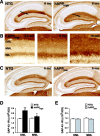Fyn kinase modulates synaptotoxicity, but not aberrant sprouting, in human amyloid precursor protein transgenic mice
- PMID: 15140940
- PMCID: PMC6729387
- DOI: 10.1523/JNEUROSCI.0277-04.2004
Fyn kinase modulates synaptotoxicity, but not aberrant sprouting, in human amyloid precursor protein transgenic mice
Abstract
Alzheimer's disease (AD), the most common neurodegenerative disorder, results in progressive degeneration of synapses and aberrant sprouting of axon terminals. The mechanisms underlying these seemingly opposing cellular phenomena are unclear. We hypothesized that Fyn kinase may play a role in one or both of these processes because it is increased in AD brains and because it is involved in synaptic plasticity and axonal outgrowth. We investigated the effects of Fyn on AD-related synaptotoxicity and aberrant axonal sprouting by ablating or overexpressing Fyn in human amyloid precursor protein (hAPP) transgenic mice. On the fyn+/+ background, hAPP/amyloid beta peptide (Abeta) decreased hippocampal levels of synaptophysin-immunoreactive presynaptic terminals (SIPTs), consistent with previous findings. On the fyn-/- background, hAPP/Abeta did not affect SIPTs. SIPT reductions correlated with hippocampal Abeta levels in hAPP/fyn+/+, but not hAPP/fyn-/-, mice suggesting that Fyn provides a critical link between hAPP/Abeta and SIPTs. Furthermore, overexpression of Fyn exacerbated SIPT reductions in hAPP mice. We also found that the susceptibility of mice to hAPP/Abeta-induced premature mortality was decreased by Fyn ablation and increased by Fyn overexpression. In contrast, axonal sprouting in the hippocampus of hAPP mice was unaffected. We conclude that Fyn-dependent pathways are critical in AD-related synaptotoxicity and that the pathogenesis of hAPP/Abeta-induced neuronal alterations may be mechanistically heterogenous.
Figures



Similar articles
-
Fyn kinase induces synaptic and cognitive impairments in a transgenic mouse model of Alzheimer's disease.J Neurosci. 2005 Oct 19;25(42):9694-703. doi: 10.1523/JNEUROSCI.2980-05.2005. J Neurosci. 2005. PMID: 16237174 Free PMC article.
-
High-level neuronal expression of abeta 1-42 in wild-type human amyloid protein precursor transgenic mice: synaptotoxicity without plaque formation.J Neurosci. 2000 Jun 1;20(11):4050-8. doi: 10.1523/JNEUROSCI.20-11-04050.2000. J Neurosci. 2000. PMID: 10818140 Free PMC article.
-
Regulation of Synaptic Amyloid-β Generation through BACE1 Retrograde Transport in a Mouse Model of Alzheimer's Disease.J Neurosci. 2017 Mar 8;37(10):2639-2655. doi: 10.1523/JNEUROSCI.2851-16.2017. Epub 2017 Feb 3. J Neurosci. 2017. PMID: 28159908 Free PMC article.
-
Fyn, a potential target for Alzheimer's disease.J Alzheimers Dis. 2011;27(2):243-52. doi: 10.3233/JAD-2011-110353. J Alzheimers Dis. 2011. PMID: 21799250 Review.
-
Targeting Fyn Kinase in Alzheimer's Disease.Biol Psychiatry. 2018 Feb 15;83(4):369-376. doi: 10.1016/j.biopsych.2017.06.004. Epub 2017 Jun 13. Biol Psychiatry. 2018. PMID: 28709498 Free PMC article. Review.
Cited by
-
Cellular prion protein and Alzheimer disease: link to oligomeric amyloid-β and neuronal cell death.Prion. 2013 Mar-Apr;7(2):114-6. doi: 10.4161/pri.22848. Epub 2012 Nov 15. Prion. 2013. PMID: 23154635 Free PMC article.
-
Tau phosphorylation pathway genes and cerebrospinal fluid tau levels in Alzheimer's disease.Am J Med Genet B Neuropsychiatr Genet. 2012 Oct;159B(7):874-83. doi: 10.1002/ajmg.b.32094. Epub 2012 Aug 27. Am J Med Genet B Neuropsychiatr Genet. 2012. PMID: 22927204 Free PMC article.
-
A diet enriched with the omega-3 fatty acid docosahexaenoic acid reduces amyloid burden in an aged Alzheimer mouse model.J Neurosci. 2005 Mar 23;25(12):3032-40. doi: 10.1523/JNEUROSCI.4225-04.2005. J Neurosci. 2005. PMID: 15788759 Free PMC article.
-
Pathogenesis of synaptic degeneration in Alzheimer's disease and Lewy body disease.Biochem Pharmacol. 2014 Apr 15;88(4):508-16. doi: 10.1016/j.bcp.2014.01.015. Epub 2014 Jan 21. Biochem Pharmacol. 2014. PMID: 24462903 Free PMC article. Review.
-
Tau-targeted treatment strategies in Alzheimer's disease.Br J Pharmacol. 2012 Mar;165(5):1246-59. doi: 10.1111/j.1476-5381.2011.01713.x. Br J Pharmacol. 2012. PMID: 22044248 Free PMC article. Review.
References
-
- Arendt T (2001) Disturbance of neuronal plasticity is a critical pathogenetic event in Alzheimer's disease. Int J Dev Neurosci 19: 231-245. - PubMed
-
- Benowitz LI, Perrone-Bizzozero NI (1991) The expression of GAP-43 in relation to neuronal growth, plasticity: when, where, how, and why? Prog Brain Res 89: 69-87. - PubMed
-
- Bi X, Gall CM, Zhou J, Lynch G (2002) Uptake and pathogenic effects of amyloid beta peptide 1-42 are enhanced by integrin antagonists and blocked by NMDA receptor antagonists. Neuroscience 112: 827-840. - PubMed
-
- Bronfman FC, Moechars D, Van Leuven F (2000) Acetylcholinesterase-positive fiber deafferentation and cell shrinkage in the septohippocampal pathway of aged amyloid precursor protein london mutant transgenic mice. Neurobiol Dis 7: 152-168. - PubMed
Publication types
MeSH terms
Substances
Grants and funding
LinkOut - more resources
Full Text Sources
Other Literature Sources
Medical
Molecular Biology Databases
Miscellaneous
